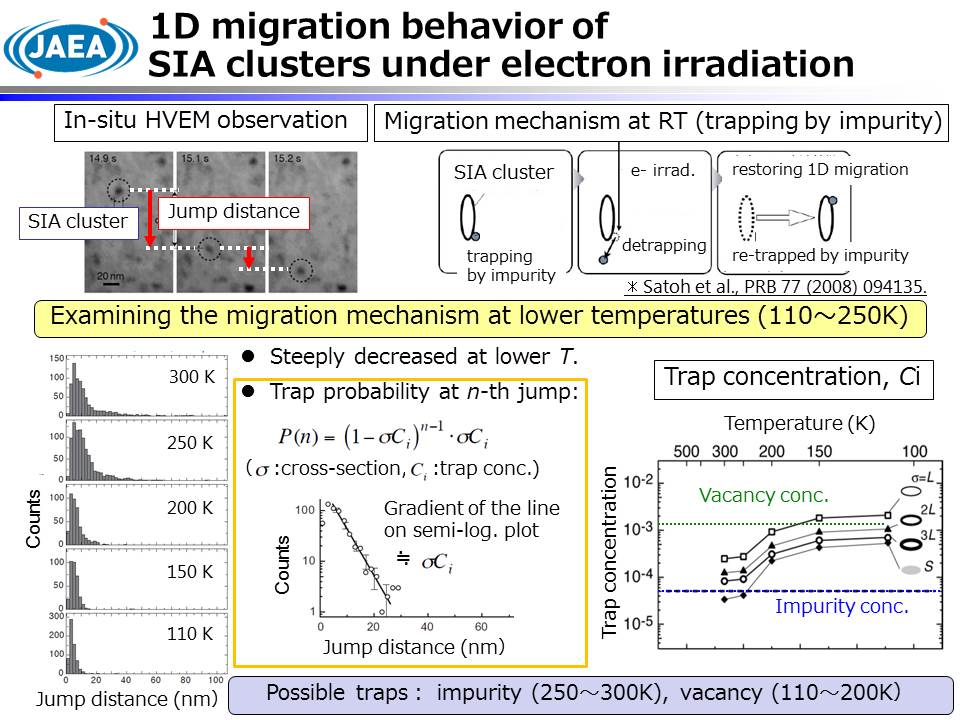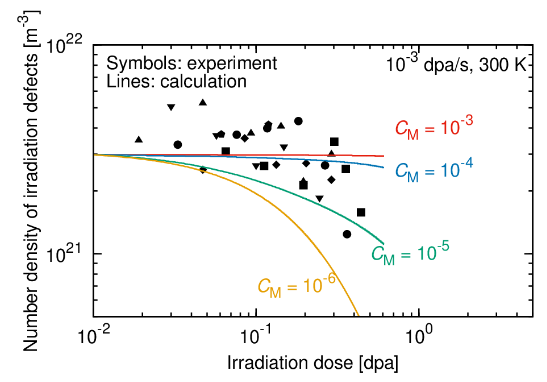
Reaction kinetics arising from the one-dimensional (1D) migration of self-interstitial atom clusters is one of the most important parameters determining microstructural evolution, and thus, degradation of material properties under cascade irradiation conditions. In situ observation using high-voltage electron microscopy (HVEM) is an efficient experimental method in the study of the basic processes of the defect cluster evolution because high-energy electron induces only point defects. We have performed in situ HVEM observation in electron-irradiated a-iron below the room temperature to extract a 1D migration model depending on the temperature.

By in situ observation using electron microscopy, we revealed a fundamental defect-migration mechanism, i.e. trapping/detrapping by impurity atoms, in pure iron. Based on the revealed mechanism, we derived the analytical model using a random walk theory, and incorporated into a reaction rate theory. Figure 1 shows how the evolution behavior of the interstitial cluster density depends on the impurity concentration in pure iron. The decreasing behavior was in a closer accordance with the experimental data with the same order of impurity concentration as experimentally deduced. This result suggests that the revealed migration mechanism is a fundamental physical process under irradiation.

Fig.1 Dependence of the defect-density evolution on the impurity concentration CM as a function of irradiation dose. Each symbol in the experimental data corresponds to an individual run.
Understanding the mechanism of the neutron irradiation-induced embrittlement of RPV steel is very important in ensuring the structural integrity in aging light water reactors. Since Cu precipitates that have formed in RPV steel which contain small amounts of Cu atoms are assumed to act as obstacles to dislocation motion, thus causing embrittlement, a large number of experimental studies have been performed in an attempt to characterize the Cu precipitates. During thermal aging, the Cu precipitates in the coherent bcc phase grow and hence lose coherency, and then change into 9R structures. As these incoherent Cu precipitates could strongly interact with dislocations, understanding the mechanism of and conditions with phase transformations appears to be a key to manage embrittlement.
Phase transformation of Cu precipitate in Fe-Cu alloy
The self-guided molecular dynamics (SGMD) method, which can enhance the conformational sampling efficiency in MD simulations, was applied in investigating the phase transformation of Cu precipitate in alpha-iron that took place during thermal aging. It was shown that the SGMD method can accelerate calculating the bcc to 9R structure transformation of a small precipitate (even 4.0nm in size), enabling the transformation without introducing any excess vacancies. The size dependence of the transformation also agreed with that seen in previous experimental studies.
Figure 1 provides an image obtained in the SGMD simulation of a [111] cross-section of a precipitate of 8.0nm diameter. A feature of that image is the appearance of a twin-like boundary lying roughly along one of the three <110> matrix directions, designated by the dotted line, between the close packed regions near the center of the precipitate.

Figure 1
Atomistic simulation of interaction between an edge dislocation and Cu precipitate
Molecular dynamics simulation of the interaction between a pure edge dislocation and spherical Cu precipitate in alpha-iron has been performed to investigate the size- and spacing- dependent obstacle strength due to the Cu precipitates, in which the effect on phase transformation of Cu precipitates obtained by the SGMD simulation as mentioned above.
Figure 2 shows atomic images of the dislocation configurations during the interaction between an edge dislocation and (a) coherent (bcc) and (b) phase-transformed Cu precipitates. Such metallographic structures increase the obstacle strength through strong pinning effects as a result of the complicated atomic rearrangement within the Cu precipitate. Figure 3 represents shear stress-strain response of alpha-iron including Cu precipitates, where two types of crystallographic structures with/without phase transformation. The maximum shear stress for the phase-transformed Cu precipitate is about 100 MPa larger than that for the bcc Cu precipitate.

Figure 2

Figure 3